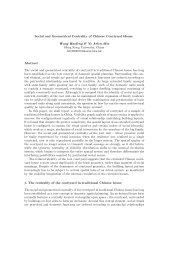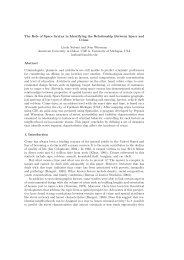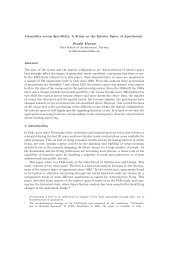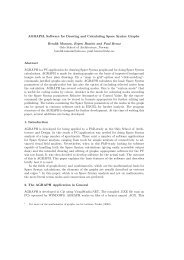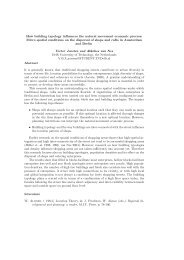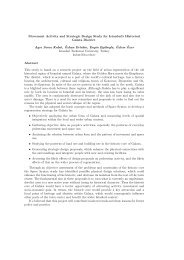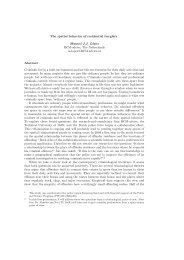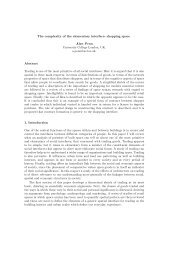High Resolution Analysis of Crime Patterns in Urban Street Networks
High Resolution Analysis of Crime Patterns in Urban Street Networks
High Resolution Analysis of Crime Patterns in Urban Street Networks
Create successful ePaper yourself
Turn your PDF publications into a flip-book with our unique Google optimized e-Paper software.
<strong>High</strong> <strong>Resolution</strong> <strong>Analysis</strong> <strong>of</strong> <strong>Crime</strong> <strong>Patterns</strong> <strong>in</strong> <strong>Urban</strong> <strong>Street</strong> <strong>Networks</strong>: an <strong>in</strong>itialstatistical sketch from an ongo<strong>in</strong>g study <strong>of</strong> a London borough 469daytime pattern <strong>of</strong> robbery <strong>in</strong> one <strong>of</strong> the high robbery neighbourhoods and the rightimage the night-time pattern. The night time pattern is much less dispersed and thanthe less numerous day-time pattern, and much more focused on the ma<strong>in</strong> arteries <strong>of</strong> thearea. Could this be l<strong>in</strong>ked to movement, and, through movement, to spatial factors? It ispossible <strong>of</strong> course that these time and space differences also relate to the type <strong>of</strong> robbery,<strong>in</strong>clud<strong>in</strong>g the degree <strong>of</strong> violence <strong>in</strong>volved, and this issue will be looked at <strong>in</strong> the next phase<strong>of</strong> this research.In what follows we first look at spatial factors associated with robbery by assembl<strong>in</strong>gthe data <strong>in</strong>to <strong>in</strong>cidence bands (as opposed to risk bands), that is <strong>in</strong>to bands on which 0,1, 2 ...n robberies occur, and exam<strong>in</strong><strong>in</strong>g any shifts <strong>in</strong> spatial pattern<strong>in</strong>g.We know first <strong>of</strong> course that <strong>in</strong>cidence rises with <strong>in</strong>creas<strong>in</strong>g length <strong>of</strong> segment, asexpected from the primary risk concept, as top left below. However, if we consider meansegment connectivity (we already know that robbery occurs on average on segments whichare less connected than those on which it does not occur), we f<strong>in</strong>d that with <strong>in</strong>creas<strong>in</strong>g<strong>in</strong>cidence, connectivity first rises but then falls sharply for the highest robbery segments,which although they constitute only about 1% <strong>of</strong> the segments, account for 17% <strong>of</strong> therobberies (Figure 235a). We f<strong>in</strong>d a similar pattern for both the connectivity <strong>of</strong> the l<strong>in</strong>es onwhich the segments fall (Figure 22 b), and for their local <strong>in</strong>tegration (Figure 235d). Theeffect is less clear for global <strong>in</strong>tegration, and does not exist for l<strong>in</strong>e length, which <strong>in</strong>creasesand then stabilises with <strong>in</strong>creas<strong>in</strong>g <strong>in</strong>cidence.S<strong>in</strong>ce the <strong>in</strong>cidence <strong>of</strong> robbery is known to vary with time <strong>of</strong> day, and s<strong>in</strong>ce people riskconditions will also vary with time <strong>of</strong> day, could these be connected to the chang<strong>in</strong>g spatialpatterns? We can explore this by divid<strong>in</strong>g robberies <strong>in</strong>to 3 hour <strong>in</strong>cidence periods, andplott<strong>in</strong>g <strong>in</strong>cidence <strong>in</strong> the charts below from left to right start<strong>in</strong>g with the O6-O9 morn<strong>in</strong>gperiod, and end<strong>in</strong>g with the 03-06 late night period (Figure 236).Figure 236 a shows that the peak is the 15-18 period, closely followed by the 21-00period, and the 18-21 period. The 15-18 period <strong>in</strong>cludes much <strong>of</strong> the even<strong>in</strong>g rush hourbut there is no comparable peak around the morn<strong>in</strong>g rush hour (the robbers are still <strong>in</strong>bed!). However, the 18-21 and 21-00 are likely to be very different <strong>in</strong> terms <strong>of</strong> pedestrianmovement, with more people around <strong>in</strong> the 18-21 period. So the 21-00 period is likelyto be higher risk. The same almost certa<strong>in</strong>ly applies to the 00-03 period when there willbe far fewer people, but nearly a many robberies, so a much higher risk. So the highest<strong>in</strong>cidence period is early even<strong>in</strong>g, but the highest risk is probably post-midnight.Figure 236b shows the degree <strong>of</strong> concentration <strong>of</strong> <strong>in</strong>cidents <strong>in</strong> specific locations bydivid<strong>in</strong>g the number <strong>of</strong> <strong>in</strong>cidents <strong>in</strong>to the number <strong>of</strong> locations. This shows that <strong>in</strong> the low<strong>in</strong>cidence period there is a greater spread <strong>of</strong> locations, while <strong>in</strong> the high <strong>in</strong>cidence periodsa greater concentration. In Figure 23 c, we look at the mean length <strong>of</strong> segment on whichrobberies occur, and f<strong>in</strong>d a complex pattern, with 06-09 happen<strong>in</strong>g on shorter segments,09-12 and 03-06 on the longest, but the peak periods dipp<strong>in</strong>g to shorter segments, andwith the period 21-00 period <strong>of</strong> second highest <strong>in</strong>cidence on the shortest segments (apartfrom the early morn<strong>in</strong>g period). The relevance <strong>of</strong> this is that shorter segments are <strong>of</strong>tenfound where blocks are smaller <strong>in</strong> ‘live centre’ areas.The pattern for segment connectivity (Figure 237d) is aga<strong>in</strong> different, with the earlymorn<strong>in</strong>g happen<strong>in</strong>g on the least connected segments and the highest risk post midnightperiod on much the highest. The early even<strong>in</strong>g periods 18-21 is on lower connected segmentsthan either <strong>of</strong> the periods before or afters, and much lower than the two nightperiods. The highest risk period is associated with then highest segment connectivity, andthis aga<strong>in</strong> is suggestive <strong>in</strong> relation to the relative sparsity <strong>of</strong> people. Robbers use more



